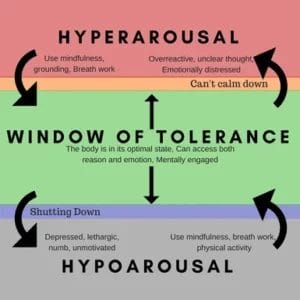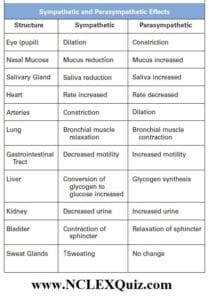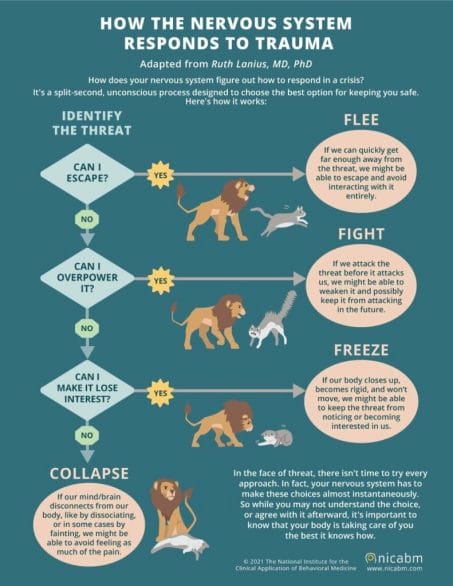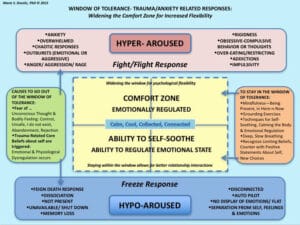Do you ever find yourself going from 1 to 100 quickly without realizing it? One moment you are calm and doing life, and the next, you find yourself feeling overwhelmed and having difficulty coping. If you have experienced trauma, one reason you might be experiencing this quick switch to instability is that you are getting shot outside your window of tolerance (WoT). A window of tolerance (WoT) is the amount to which a person can cope with distressing thoughts, feelings, images, and body sensations. When we are within our WoT, we can learn, engage with others, and self-regulate effectively. It is also the state needed for therapeutic interventions to be most effective. When we exceed our WoT, we go into one of two states: Hyper-Arousal or Hypo-Arousal. These states are our body and mind’s way of communicating difficulty coping and needing our attention on self-regulation. Throughout this article, you will learn more about the origins of a window of tolerance and hyper and hypo-arousal.
Table of Contents
What Counts as Trauma?
Trauma is any life experience that is so impactful it changes or influences your worldview, your view of yourself, and/or how you engage in the world. Trauma is often broken into “Big T” and “Small t” traumas. Big T traumas are what people tend to think of when they think of the word trauma, such as a car accident, assault, a natural disaster, or just about anything you experience or witness that makes you fear for your life. Small t traumas are often overlooked traumas but can have significant impacts on our lives, such as being bullied, being food insecure, being exposed to neighborhood violence, having a miscarriage, your parents giving love in a different way than you receive love growing up, or being fired from your dream job.
The mental health diagnosis of Post-Traumatic Stress Disorder (PTSD) tends to be given to those who have experienced Big T traumas, though the psychology world has learned that the cumulative impact of Small t traumas can have the same psychological impact as one Big T trauma. While not everyone that goes through trauma will develop clinically diagnosable PTSD, most will still experience a trauma response of some type, impacting one’s Autonomic Nervous System (ANS) and their WoT. Below I will explain what each of these terms means.
What is a Window of Tolerance?

We all have a WoT. We all have a different WoT for different events and at different times. For example, on the weekend, your WoT for your toddler’s constant curiosity and wonder for the world through questioning everything may be much greater than after a long day at work. You may find yourself having patience with all of the questions on the weekends but getting annoyed with the questions during the evening after a work day. When our WoT is wider, we have an easier time coping with stressful experiences, but when it is limited, we find more difficulty managing our emotions and responses.
Unfortunately, our WoT is impacted when we experience traumas, oftentimes resulting in the size of our window shrinking. The more unresolved traumas, the smaller that window gets and the more work we need to do to keep ourselves within the WoT. Adapting a smaller WoT is our brain’s way of protecting us. Protection becomes important in therapy, as healing and therapeutic progress can only occur when one is within their WoT.
What happens when we experience a traumatic event?
When we encounter a threat, our ANS will turn on the Sympathetic Nervous System (SNS) and turn off the Parasympathetic Nervous System (PNS) while making an instantaneous determination of whether to engage in a Fight, Flight, or Freeze response. When a person enters a state of Fight or Flight, the SNS initiates a state of hyper-arousal, with the body becoming activated to take the actions needed to engage with the threat or seek safety. Other times, it is determined that not reacting will be the safest option, which tells the SNS to go into Hypo-arousal, which is what initiates a person going into a Freeze state. When the threat passes, and we are once again safe, the ANS will turn off the SNS and turn the PNS back on, to resume a state of rest.

Fight, Flight, or Freeze

When we feel triggered, our mind, on an unconscious level, will assess the threat and determine what is the best course of action as a means for survival. The three most commonly known responses are Fight, Flight, and Freeze. These responses are an evolutionary development that protects us when encountering potential dangers. Your brain decides which course of action to take before consciously registering the need to decide.
Our body moves through the trauma experience, and our mind creates neural pathways to remember the event for potential re-experiencing of this threat or trauma in the future. Research shows that these memories are stored in both our minds and bodies. Our minds will generalize our learned experiences to help avoid similar threats or traumas in the future. This generalization process can result in our mind and body not having the capacity to properly delineate between actual potential threats or traumas and something that might mimic the trauma. For example, an individual who had a parent be manipulative of their feelings while growing up may read their adult partner’s curiosity and genuine desire for understanding as manipulation. This individual’s brain subconsciously assesses their partner’s questioning and registers the interaction as a need to fight, flight, or freeze.
What is the difference between hyper-arousal and hypo-arousal?

Hyper-arousal and hypo-arousal are examples of your body and mind trying to protect you from the threat of danger. When we experience hyper-arousal, our sympathetic nervous system (SNS) turns on, which tells the non-necessary body functions to cease (i.e. digestion) and the necessary body functions to go on high alert (i.e. your eye-sight sharpens, and blood flow increases to the muscles). When we experience hypo-arousal, our body and mind “shut down.” The tension in our muscles is lax; we’re not taking in new information; oftentimes, a person describes feeling numb and disconnected.
When we experience a trauma response, PTSD or otherwise, some of the present symptoms are related to being hyper-aroused or hypo-aroused. For example, when one is stuck in a state of hyper-arousal, it is common to experience being hyper-alert to one’s surroundings and potential threats of danger, having a strong startle response, and intense emotional expression. When one is stuck in a state of hypo-arousal, it is common to experience dissociation, poor memory recall, low energy levels, and difficulty concentrating.
Usually, when a threat has passed, our parasympathetic nervous system (PNS) will automatically switch on and tell our body to start to calm down, as our body does not and cannot maintain a spiked autonomic nervous system. There are times, though, when we experience a traumatic event, our body can not recognize the threat as having passed, and as such, we remain in a prolonged fight, flight, or freeze response state. This is what one experiences when they have any type of trauma response and are outside their window of tolerance. The inability to discern from past and present by our brain is why the past may feel like it’s ongoing and still occurring. Our mind does not realize we have reached safety and thus continues to try to protect us, though it is unintentionally actually holding us back from healing or even harming us.
What happens if I’m stuck outside my Window of Tolerance, in a state of fight, flight, or freeze?
Being within one’s WoT is our body’s natural state of homeostasis. Our mind can more easily take in and process information, we can regulate our emotions better, and our body and brain function as it should. Remaining stuck in a fight, flight, or freeze response for prolonged periods of time is unhealthy for our minds and body. Physically and mentally, our body is attempting to remain in either a heightened or depressed state, neither of which were intended to be remained in, evolutionarily speaking. The states of fight, flight, or freeze were only intended to be temporary states until we resumed safety. Unfortunately, evolution did not account for humans to progress into a lived environment that has increased and prolonged threat risks (i.e. the very recent example of COVID-19) as well as having non-threatening experiences to so closely mimic threatening ones (i.e. something positive like fireworks that sound very similar to harmful sounds like weapons going off).
Remaining outside our WoT can physically impact our blood pressure, heart rate, lung capacity, digestive system, and sugar levels, which can have vast impacts on our overall functioning and health. The impact of these systems is directly related to the SNS keeping specific bodily systems on and others off. We must resume a place within our WoT so the PNS can switch on and let our body resume normal functioning. The cognitive impact of remaining in the fight, flight, and freeze response for too long includes difficulty planning or thinking long-term, poor memory development and recall, and difficulty learning new things. It is common for people with their SNS stuck on to feeling chronic fatigue, both physically and mentally, chronic pain, and chronic health conditions due to the body releasing more Cortisol (the body’s stress hormone) than the body can absorb, resulting in it being stored incorrectly in the body as it has nowhere else to go.
Research also shows that remaining within that fight, flight, or freeze response can impact our memory storage. The brain creates 4 different types of memories that can all be impacted by the experience of trauma. The two aspects of memory that are impacted by trauma that we see within one’s trauma response are the impact on both episodic memory (the details of an event) and emotional memory (how that event felt). When one is stuck with their SNS on, and they have excessive amounts of Cortisol being released, we know this can shut down the episodic memory process. We also know that this continued state impacts the functioning of the Hippocampus, which is in charge of moving experiences from the short-term memory bank to the long-term. The increase in cortisol and decrease in hippocampus functioning combined with the brain’s attempts to protect oneself from the recall of traumatic experiences by fragmenting it results in trauma memories never properly being transferred out of the short-term memory center and the inability of all 4 parts of the memory being integrated. Together, this contributes to the re-experiencing and intrusive symptoms that are associated with a trauma response, as well as why it is common to have an incomplete recall of the trauma experience.
How do I get out of a fight, flight, or freeze response and back into my Window of Tolerance?
One of the most important aspects of any form of trauma therapy is learning coping skills to either keep oneself in their WoT or to be able to bring oneself back into it when triggered. These types of skills help calm the Amygdala (the emotion center of the brain) and the Autonomic Nervous System (ANS). The number one most effective method for managing one’s WoT is practice of mindfulness strategies, as they can help turn the PNS back on. What these coping skills do is keep you grounded in the present moment to help counteract the effects of the trauma trigger trying to bring you into the past, oftentimes by transitioning your focus from your mind to your body.
Here are 10 methods to feel calmer in a triggered state and to return to your Window of Tolerance:
- Doing long, slow deep diaphragm breaths (from the stomach, not the lungs).
- Counting or multiplying by 5,
- Focusing on the comparison of textures of items around you
- Focusing on your 5 senses (identify and focus on 3 things you can see, 3 things you can hear, 3 things you can feel, 3 things you smell and 3 things you can taste).
- Sitting upright in a chair and focusing on the feeling of using tension to press your feet against the floor
- Doing simple stretches and focusing on how your body feels doing so
- Choose a category and name each things you can see in that category
- Doing a body scan from the top of your head to your toes
- Focus on a simple mindfulness activity, whether it is coloring, knitting, or even playing solitaire
- Sit with your pet and focus on how it feels to stroke and hold them
How do I increase my Window of Tolerance so that I don’t go into fight, flight, or freeze so often?
Expanding your WoT will help you as you work through your trauma response. There is no one set thing that will widen your window of tolerance, instead it is a series of steps taken to take better care of yourself, overall. As you become more comfortable using coping skills to stay within your WoT, you will also develop the skills needed to expand it.
By increasing your ability to be within your WoT, you are also widening the window itself. As you build a practice and engage in emotional regulation strategies, experience more relaxation and develop a more accepting sense of self (all which will allow you to remain within your WoT), your Wot itself will expand as what you can tolerate will be increasing. Below are some suggestions to help with this:
- Become aware of the red flags that you are approaching the edge of your WoT, and practice the coping skills that keep you within it.
- Practice sitting within your discomfort (start slow). As you become more accustomed to experiencing discomfort, you will be able to tolerate it more and those feelings won’t result in you slipping out of your WoT.
- Practice mindfulness on a regular basis. This helps keep you attuned to your body and mind.
- Engage in self-reflection when you are finding yourself activated. What is happening within your body? What are the thoughts and feelings associated with it? What makes it feel threatening?
- Engage in acts of self-care. This can be exercising, doing a fun activity, spending time relaxing, or socializing. These positive actions will help you feel better about yourself.
- Practice self-compassion. We are usually meaner to ourselves than we would be to others. Treat yourself as you would a friend.
- Let go of shame. Guilt is a feeling but shame is a belief about ourselves. Shame holds you stuck emotionally and stunts your ability to grow. You are not your actions/thoughts/feelings/etc. Show empathy to yourself as you would others.
- Sign up for therapy. Having a safe space to process and reflect can be very helpful.
While most everyone in life will experience trauma at some point in their lives, some people will develop PTSD in response to the trauma and their WoT will be affected. If you find that this resonates with you, a trained trauma-informed therapist can help you develop the coping skills needed so you feel equipped to begin facing the traumatic event in a supportive and safe environment.







